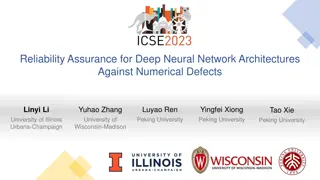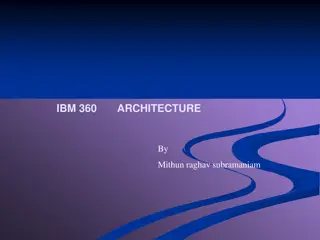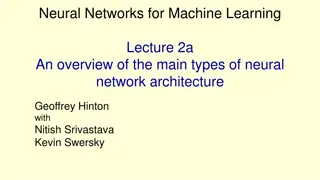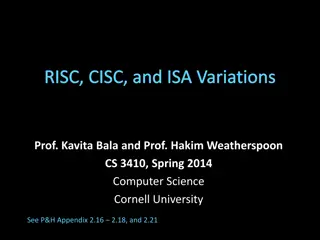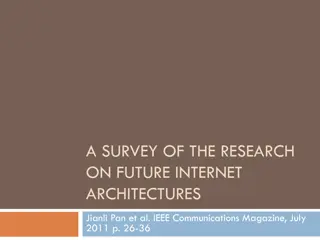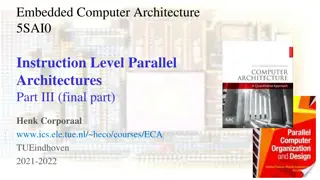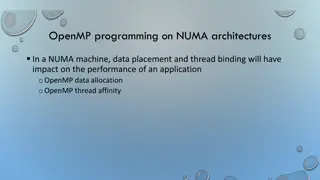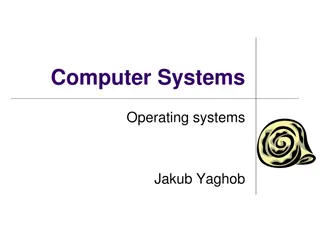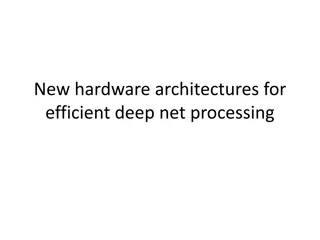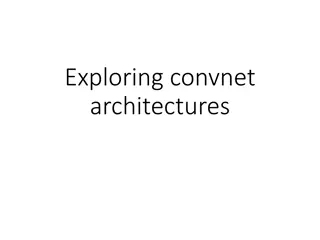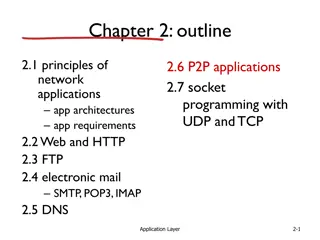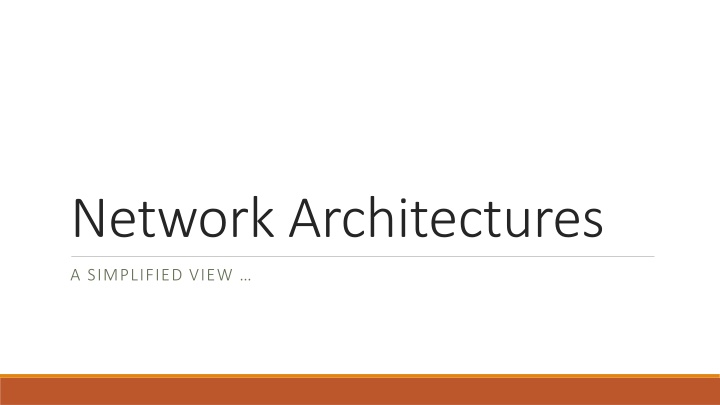
Network Architectures: A Simplified Overview
This session provides a simplified view of network architectures, exploring the history, development, and key technologies that have shaped modern networking. From the inception of ARPANET to the evolution of protocols like TCP/IP and IPv4, learn how networks have revolutionized communication and information sharing.
Download Presentation

Please find below an Image/Link to download the presentation.
The content on the website is provided AS IS for your information and personal use only. It may not be sold, licensed, or shared on other websites without obtaining consent from the author. If you encounter any issues during the download, it is possible that the publisher has removed the file from their server.
You are allowed to download the files provided on this website for personal or commercial use, subject to the condition that they are used lawfully. All files are the property of their respective owners.
The content on the website is provided AS IS for your information and personal use only. It may not be sold, licensed, or shared on other websites without obtaining consent from the author.
E N D
Presentation Transcript
Network Architectures A SIMPLIFIED VIEW
Disclaimer The purpose of this session is NOT to make you network engineers We will look briefly at networks, structures of networks and a little bit at protocols The goal is mainly to give you an overview, with enough understanding to comprehend how it affects architecture and design
The story so far We have looked at computers, Operating Systems and Applications We have looked at how applications talk to each other on the same computer In the 1970s it became apparent that it would be useful to have computers talk to each other At first, just sending data with an approach to sharing information, especially between researchers This evolved to having applications communicate data And so, networks were born
History (condensed) 1976 1978 Ginny Strazisar developed the first true IP router, originally called a gateway, in 1976. Bob Kahn invented the TCP/IP protocol for networks and developed it, with help from Vint Cerf, in 1978. Year Event 1961 The idea of ARPANET, one of the earliest computer networks, was proposed by Leonard Kleinrock in 1961, in his paper titled "Information Flow in Large Communication Nets." 1981 Internet Protocol version 4, or IPv4, was officially defined in RFC 791 in 1981. IPv4 was the first major version of the Internet protocol. 1969 ARPANET was one of the first computer networks to use packet switching. Development of ARPANET started in 1966, and the first two nodes, UCLA and SRI (Standford Research Institute), were connected, officially starting ARPANET in 1969. 1983 1983 1988 ARPANET finished the transition to using TCP/IP in 1983. Paul Mockapetris and Jon Postel implement the first DNS in 1983. WaveLAN network technology, the official precursor to Wi-Fi, was introduced to the market by AT&T, Lucent, and NCR in 1988. 1969 The first RFC surfaced in April 1969, as a document to define and provide information about computer communications, network protocols, and procedures. 1988 Details about network firewall technology was first published in 1988. The published paper discussed the first firewall, called a packet filter firewall, that was developed by Digital Equipment Corporation the same year. 1969 The first network switch and IMP (Interface Message Processor) was sent to UCLA on August 29, 1969. It was used to send the first data transmission on ARPANET. 1990 Kalpana, a U.S. network hardware company, developed and introduced the first network switch in 1990. 1969 The Internet was officially born, with the first data transmission being sent between UCLA and SRI on October 29, 1969, at 10:30 p.m. 1996 IPv6 was introduced in 1996 as an improvement over IPv4, including a wider range of IP addresses, improved routing, and embedded encryption. 1997 The first version of the 802.11standard for Wi-Fi is introduced in June 1997, providing transmission speeds up to 2 Mbps. 1970 Steve Crocker and a team at UCLA released NCP (NetWare Core Protocol) in 1970. NCP is a file sharing protocol for use with NetWare. 1999 The WEP encryption protocol for Wi-Fi is introduced in September 1999, for use with 802.11b. 1971 Ray Tomlinson sent the first e-mail in 1971. 2003 802.11gdevices were available to the public starting in January 2003, providing transmission speeds up to 20 Mbps. 1973 Ethernet is developed by Robert Metcalfe in 1973 while working at Xerox PARC. 1974 The first routers were used at Xerox in 1974. However, these first routers were not considered true IP routers. 2009 The 802.11nstandard for Wi-Fi was made official in 2009. It provides higher transfer speeds over 802.11a and 802.11g, and it can operate on the 2.4 GHz and 5 GHz bandwidths. https://www.computerhope.com/history/network.htm
Networking terms Domain Name System (DNS): DNS translates Internet addresses (such as www.dummies.com) to IP addresses (such as 208.215.179.146) so routers can find Web sites (among other things) on the Internet. Typically, your ISP will provide you a primary and secondary DNS server address. You configure DNS in your computer s network settings (or set it up on your DHCP server to automatically configure your computers and other network devices with DNS information). Dynamic Host Configuration Protocol (DHCP): DHCP automatically assigns IP addresses to the devices on your network. You pre-configure a range of allowable IP addresses on a DHCP server (such as a router or computer) that runs on your network. Ethernet: Ethernet is a networking standard. Although there are other types of networks, Ethernet is by far the most common and is almost exclusively the only standard used in home networking. You will encounter this term frequently when shopping for various network hardware, such as routers, modems, and cables. Virtual Private Network (VPN): A VPN allows two networks to be connected securely over the Internet as if they were one network. For example, you might use a VPN to connect your home network to your corporate network (if your company permits you to connect to the office from home).
Networking Architecture terms Topology Network topologies are categorized into the following basic types: Bus: Common backbone to connect all devices (like a hardware bus) Ring: All messages travel through a ring in the same direction (either clockwise or counterclockwise). A failure in any cable or device breaks the loop and can take down the network. Star: A star network features a central connection point called a hub node that is either a network hub, switch or router (common in homes) Tree: Joins multiple Star networks onto a bus Mesh: Multiple routes from source to destination. WANs are Mesh networks https://www.lifewire.com/computer-network-topology-817884
Think domains, subnets Most networks today are hybrids Topologies BUS MESH TREE STAR
Network Architecture terms Protocols The communications architecture for sending/ receiving data over networks Low level protocols: Layer 7 (Application) TCP/ IP, Token Ring Layer 6 (Presentation) Application Layer: OSI 7 Layer model Layer 5 (Session) FTP, HTTP, SMTP, POP3, SMB, Layer 4 (Transport) Layer 3 (Network) Layer 2 (Data Link) APIs are built on Layer 7 protocols Layer 1 (Physical) https://osi-model.com/
Network Implementations of the OSI Model OSI TCP/IP SNA DECNET Layer 7 (Application) End User Application Layer 6 (Presentation) NAU Services Telnet, FTP, HTTP Data Flow Control Layer 5 (Session) (None) Transmission Control Layer 4 (Transport) TCP or UDP Network Services Path Control Layer 3 (Network) IP Transport Layer 2 (Data Link) Data Control Layer Data Control Layer Network Access Layer Layer 1 (Physical) Physical Physical History of OSI: https://spectrum.ieee.org/tech-history/cyberspace/osi-the-internet-that-wasnt Tanenbaum, Computer Networks, 1981, p. 22
Impact on Software architecture Distribution of components Each network hop adds to delays Communications delays (network protocols) Processing delays (logic and data transformation per component) Dealing with firewalls and network segments Management of components How are failures managed? (You have no control over a remote component) API management What is the API? How is it structured? How is it controlled? Protocols? How efficient is the protocol? Is encryption involved?
Simple Network applications Some of the earliest network applications were Email and FTP SNDMSG a precursor to SMTP. Used FTP MAIL command to transmit a message between computers connected by the ARPANET. Evolved into SMTP. Let s see how SMTP works https://stacks.stanford.edu/file/druid:br059ts4875/br059ts4875.pdf
Email -- Send The simple act of sending an email relies on the SMTP (Simple Mail Transfer Protocol) and multiple steps along the way get the message from you to the destination kalrabb@rit.edu When you click Send 1. The message is wrapped in the SMTP protocol SMTP Server DNS 2. The message is encoded and sent to your local SMTP server 3. The recipient domain is extracted 4. The DNS server is located to find the receiving domain 5. The message is send to the domain kalrabb@rit.edu 6. The Domain Server locates the receiving SMTP server Domain Server Receiving SMTP Server 7. The email is stored on the receiving SMTP server 8. The process has many steps, and can fail in multiple places This is why mail servers may accept your email, but an hour later, you might get a send failure Pull email: POP or IMAP
Protocols: Text based Basically, open a port, send commands https://docs.microsoft.com/en- us/Exchange/mail-flow/test-smtp-with- telnet?view=exchserver-2019 > telnet > open mymailserver.smtp.com 25 //the port > EHLO mydomain.com > MAIL FROM: kalrabb@mydomain.com > RCPT TO: sendto@theirdomain.net > DATA < .>
With smtp-server.rit.edu $ telnet smtp-server.rit.edu 25 Trying 129.21.1.100... Connected to smtp-server.rit.edu. Escape character is '^]'. 220 ************************* HELO 250 smtp-server.rit.edu MAIL FROM: wksvse@rit.edu 250 sender <wksvse@rit.edu> ok RCPT TO: wksvse@rit.edu 250 recipient <wksvse@rit.edu> ok DATA 354 go ahead Subject: Test Email This is the body of the email. This is a second line in the body of the email. . 250 ok: Message 147214628 accepted QUIT 221 smtp-server.rit.edu Connection closed by foreign host.
Other notes Email was (like most of the internet), first conceived with simple text data in mind. This was soon found to be inadequate One of the notable limitations of RFC 821/822 based mail systems is the fact that they limit the contents of electronic mail messages to relatively short lines (from MIME RFC https://tools.ietf.org/html/rfc2045) MIME (Multi-part Internet Mail Extensions) allows encoding non-textual data (e.g. binary) and large data sets in multiple segments) This is what enables attachments and even though it was designed for email, this is extensively used in HTTP data/ file transfers! Wherever you see content-type this is from MIME! We will see more of this during the main Project
Exploring Network Protocols Assignment: - Using telnet command line, you will connect to and send email via SMTP (use smtp-server.rit.edu) - Using telnet command line, you will connect to and send a file via FTP (https://docs.microsoft.com/en-us/windows-server/administration/windows- commands/ftp#:~:text=The%20ftp%20command-line%20parameters%20are%20case- sensitive.%20This%20command,sub- environment%20in%20which%20you%20can%20use%20ftp%20commands.) Using FTP to seappserver3.rit.edu, switch to the section_1 directory and upload a text file containing your smtp command history for sending an email. Use the following username/password combination: ftp_activity/ftp_activity_password

